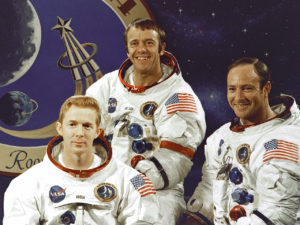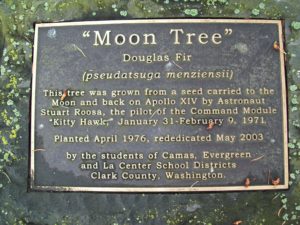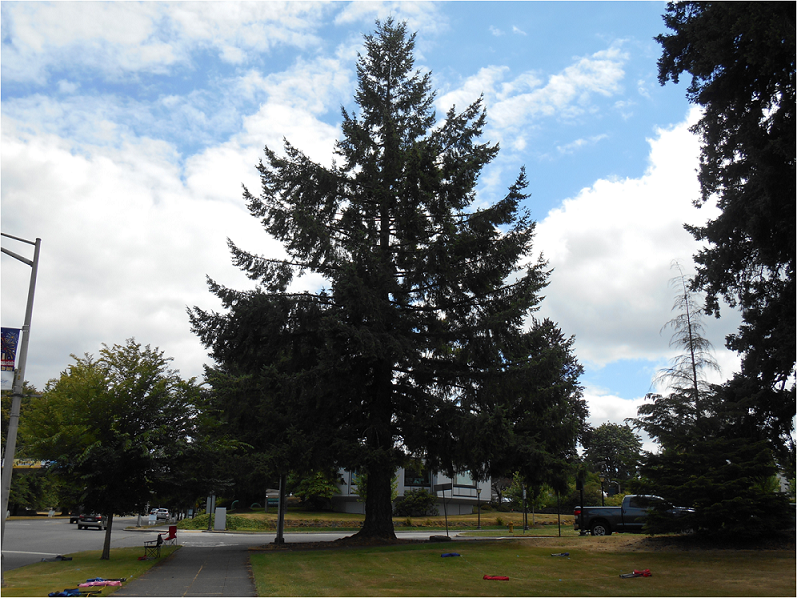The Washington State Capitol campus in Olympia is a wonderful place to visit. The campus landscaping includes many interesting trees. One of the farthest traveled of these trees is a Douglas fir (pseudotsuga menziesii) located on Capitol Way near the Tivoli Fountain.
 Nicknamed the “moon tree,” it was grown from a sample of seeds carried on the Apollo 14 mission to the moon as part of the United States Bicentennial celebration in 1976, which honored two hundred years of American independence. It is a living reminder of an amazing time in the space age when humans escaped the bounds of earth and visited the moon.
Nicknamed the “moon tree,” it was grown from a sample of seeds carried on the Apollo 14 mission to the moon as part of the United States Bicentennial celebration in 1976, which honored two hundred years of American independence. It is a living reminder of an amazing time in the space age when humans escaped the bounds of earth and visited the moon.

The Apollo 14 mission was the third successful lunar landing of the National Aeronautics and Space Administration (NASA). Lasting from January 31 to February 9, 1971, the mission followed the failed Apollo 13 flight and was considered a special success. Apollo 14’s crew set records for the longest time (33 hours) on the moon and distance traveled. They also transmitted the first color television footage from the moon and collected the largest (ninety-four pounds) of lunar soil and rock for scientific study by teams from around the globe.
Apollo 14 was crewed by Alan Shepherd, Edgar Mitchell and Stuart Roosa. Serving as mission commander, Shepherd (1923-1998) was the first American and second human (after Russian cosmonaut Yuri Gagarin) in space. At age 47 he was also the oldest man to ever step foot on the moon where he hit some golf balls. Edgar Mitchell (1930-2016) served as lunar module pilot and also landed on the moon with Shepherd on February 5, 1971. Pilot Stuart Roosa remained in the command module in lunar orbit.
Roosa (1933-1994) carried a collection of hundreds of tree seeds in his personal kit. An Air Forest test pilot and former smokejumper for the United States Forest Service (USFS), Roosa participated in the Apollo 14 mission and inspired a joint NASA and USFS project to see how trees exposed to space travel would grow on earth. Saving some control seeds for comparison, Roosa selected loblolly pine, sycamore, sweet gum, redwood and Douglas fir seeds to take on the flight. He piloted the command module “Kitty Hawk” in orbit around the moon; thus, the seeds flew around the moon and did not touch the surface. The seeds were returned to earth with the crew on the completion of their mission.

Disaster nearly struck when the canister containing the seeds burst during decontamination in a vacuum chamber, exposing them to a dangerous vacuum. The seeds somehow survived, and nearly all of them were successfully germinated by the USFS. Grown into seedlings, the trees were given away to different state forestry organizations to be planted. As part of American Bicentennial celebrations, the trees were planted across the nation, including sites such as Washington Square in Philadelphia, Valley Forge, International Forest of Friendship in Kansas, and the White House. Others were given internationally to Brazil, Switzerland and Japan. Still more were planted at universities and NASA centers. Although no comprehensive list was ever made of the trees, a survey by NASA historians 20 years after Apollo 14 shows that, as predicted, the surviving trees which travelled into space are indistinguishable from the control trees that never left Earth.
Olympia’s moon tree was planted in April 1976 on the State Capitol Campus. The tree was rededicated in May 2003 and a plaque installed through the efforts of students from Camas, Evergreen and La Center school districts in Clark County. Two hundred and fifty students attended the ceremony, some of them dressed in homemade spacesuits for the special occasion. NASA astronaut Dr. James Reilly helped dedicate the plaque. A geologist, he has been on three, separate space shuttle missions, working on both the Mir and International Space Stations. Reilly retired from NASA in May 2008.

Today, the tree still grows, a powerful symbol of the space age and its legacy. It is part of a state capitol campus that encompasses state buildings, historic monuments, trees and other plants. The campus, which belongs to the people of Washington, is open to visitors. Information on tours is available at Washington State Capitol Visitors Services (360-902-8880) or on their website.
Special thanks to Marygrace Jennings of the Washington State Department of Enterprise Services for help with this project.




















































